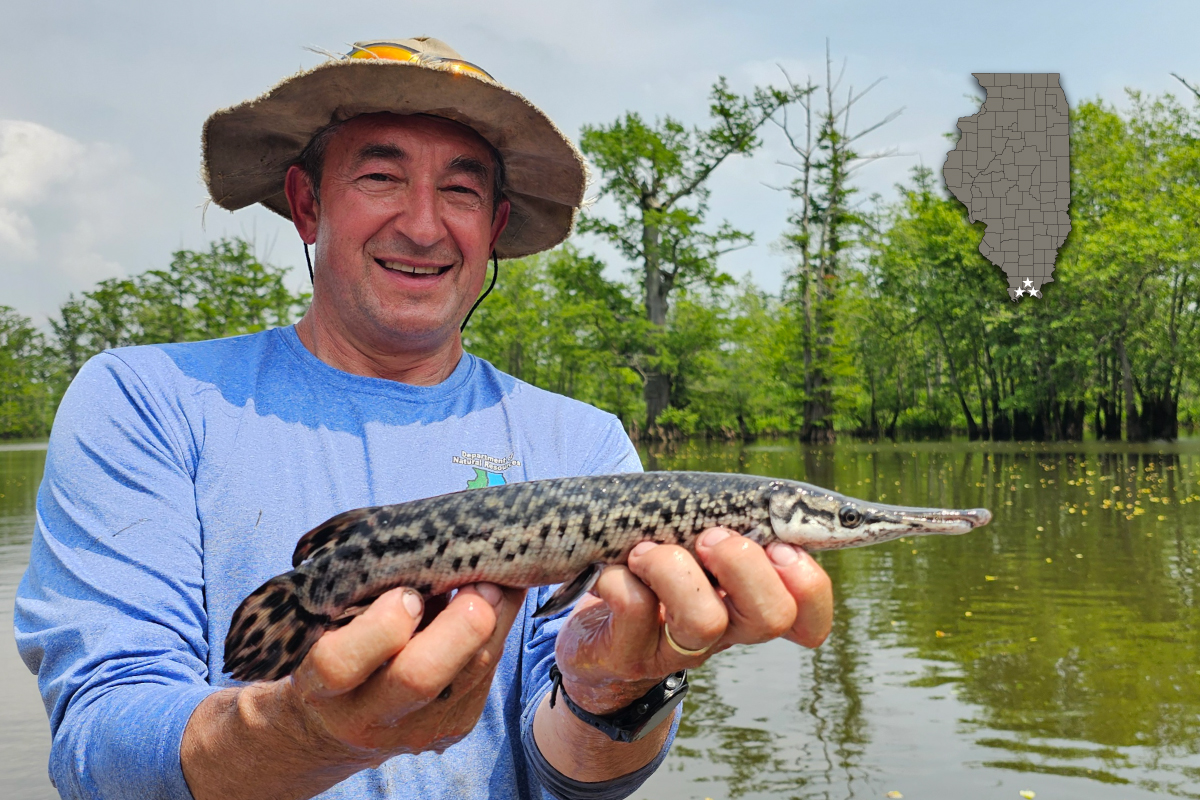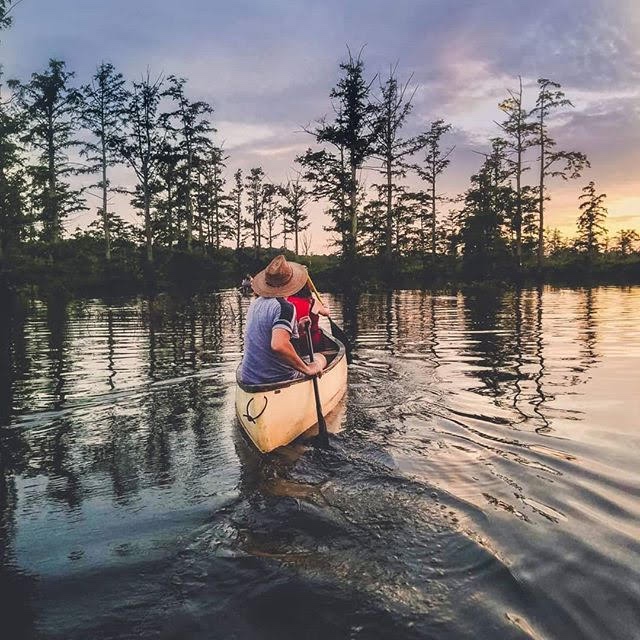
All photos courtesy of the Illinois Department of Natural Resources Division of Fisheries.



All photos courtesy of the Illinois Department of Natural Resources Division of Fisheries.
Imagine canoeing among the largest and oldest cypress trees in Illinois in the floodplain of the Cache River, and up beside your canoe surfaces a giant alligator gar for a quick breath of oxygen. Are you scared of, or amazed at, what may soon regularly occur in this unique aquatic ecosystem in southern Illinois?

On June 4, 2025, the Illinois Department of Natural Resources (IDNR) made this experience one step closer to reality. Eighty-one alligator gar, averaging 14 inches in length and .6 pounds in weight were stocked into the Lower Cache River wetlands near the town of Perks.
The reasons for reintroducing the alligator gar are twofold: Bringing back an extirpated species to Illinois waters is one of the goals. In addition, the alligator gar is becoming a popular trophy quarry for anglers and bow fishers in the southern part of their range.
Alligator gar (Atractosteus spatula) populations have been declining within their historic range for at least the past 50 years and were extirpated from much of the northern reaches (Nature Serve 2015). Declines have been attributed to several factors, most notably over-exploitation and loss of important backwater spawning habitats from the construction of levees and lock-and-dams beginning in the early 1900s.

A comprehensive account of the historic distribution of alligator gar in Illinois was published by William J. Poly in the Transactions of the Illinois State Academy of Science (2001). Poly states that the last alligator gar captured in Illinois (prior to reintroduction) was caught on hook and line from the Cache-Mississippi Diversion Channel about 2.5 miles northwest of Klondike, Alexander County, in 1966. This specimen was about 7 feet in length and weighed approximately 130 pounds.
In 1933, Wilbur M. Luce reported in the publication A Survey of the Fishery of the Kaskaskia River that “this fish was common at certain times near the mouth of the Kaskaskia River…rolling on the surface of the water near Chester.” There were other reports of alligator gar being caught throughout much of the state up to the fateful 1960s: the Big Muddy River and Wabash River in the late 1800s, the Illinois River and Mississippi River from the 1920s through 1960s, and a 5-footer caught by a commercial fisherman in 1964 from Horseshoe Lake in Alexander County.
Alfred C. Weed, the Assistant Curator of Fishes at the Field Museum of Natural History in Chicago, wrote about the alligator gar in 1923 “It is common in the Mississippi River about to St. Louis and is often seen as far as the mouth of the Illinois River. Some are taken in the latter stream, almost every year, about as far up as Beardstown, Illinois.”
In Illinois, the alligator gar was most strongly impacted by the draining of backwater lakes and swamps and the extensive construction of locks, dams and levees along the larger rivers. Much of the habitat that these fish relied upon was eliminated. And remaining backwater habitat was further degraded by changes in water levels, sedimentation, and the destructive habits of common carp and later grass carp. Several species of Illinois fish that were once abundant in such habitats have experienced a similar decline over the years.
The alligator gar is the largest of the gar species and second largest freshwater fish in North America, next to the white sturgeon (Acipenser transmontanus). The alligator gar is identified from the other gar species by having a short, broad snout, heavier and broader body, and two rows of teeth in the upper jaw. In Illinois, longnose gar, shortnose gar and spotted gar are also found throughout the state. Alligator gar take from 8 to 10 years to reach sexual maturity and have been documented to reach close to 100 years old in the southern United States.
The alligator gar has been a largely misunderstood species. An ancient, primitive species, the alligator gar evolved in these waters for millions of years. To remove such a species, especially a top predator or keystone species, from the ecological equation can have drastic and far-reaching effects on the whole river population.
Alligator gar are opportunistic feeders. Their diet depends on the easiest, most readily available food source. A lazy, lie-in-wait predator, they do not expend energy chasing down prey items and have been known to scavenge on dead items, in addition to consuming live items. Increasingly, and likely because of the monstrous sizes they can achieve, these ancient fish are valued as sportfish, a status not historically accomplished.
From 2010 to 2025, IDNR stocked 21,665 alligator gar into 12 water bodies in Illinois. These young-of-the-year fish are obtained from the U. S. Fish and Wildlife Service (USFWS) through their Pvt. John Allen National Hatchery in Tupelo, Mississippi. Personnel at the national hatchery collect brood fish each spring from the lower Mississippi River for this propagation. They produce fry alligator gar from these fish and then transport to them state fish and wildlife agencies. The USFWS has partnered with 13 states in the historic range of the alligator gar for their management and reintroduction.
The 81 fish stocked into the Cache River in 2025 were reared from the fry received at the IDNR Jake Wolf Memorial Fish Hatchery in May 2024. They were part of a small batch that was transferred that fall to the Constellation Energy Quad Cities Clean Energy Center. These fish were reared in raceways for the remainder of 2024 and into 2025 for the potential use as propagation hosts for the yellow sandshell mussel, currently an endangered species in Iowa, Ohio and Wisconsin. Before stocking, these fish were implanted with an internal PIT tag for future individual identification.
The fish management and research in the Cache River and other waters stocked with alligator gar may allow these fish to contribute to our knowledge on their reintroduction back into Illinois. More information on the alligator gar stocking and management plan for Illinois can be found at IFishIllinois.
Mark Denzer is the Natural Resources Coordinator at Little Grassy Fish Hatchery in Makanda, where he gives daily tours to the public. Born and raised in Champaign, Denzer has made his home in southern Illinois for 30 years where he can be found foraging, fishing, paddling or exploring a creek. Over the last 18 months he has enjoyed revitalizing the hatchery visitors center with new exhibits, aquaria and displays and engaging youth with his new program referred to as Fish Journeys. Public tours of the hatcheries are available by appointment by calling (618) 529-4100 or emailing mark.denzer@illinois.gov.
Rob Hilsabeck is employed by the Illinois Department of Natural Resources, serving as a district fisheries biologist for the last 31 years. On August 1, 2025, he started his retirement job as the Region 1 Streams Biologist for IDNR Fisheries. He has found IDNR Fisheries to be an extremely rewarding and his “dream” job. The variety of job duties from youth education to management provide ample opportunities to share fisheries activities with and for the public. The fisheries personnel and aquatic resources in Illinois have provided Hilsabeck knowledgeable and memorable career experiences. Hilsabeck and his wife Lora have raised three children on a retired farm in rural Peoria County; Briar, Sorin and Kyra are all in college now. The continued sparkle in their eyes and energy to pursue their dreams keeps him hopeful for the future!
Submit a question for the author